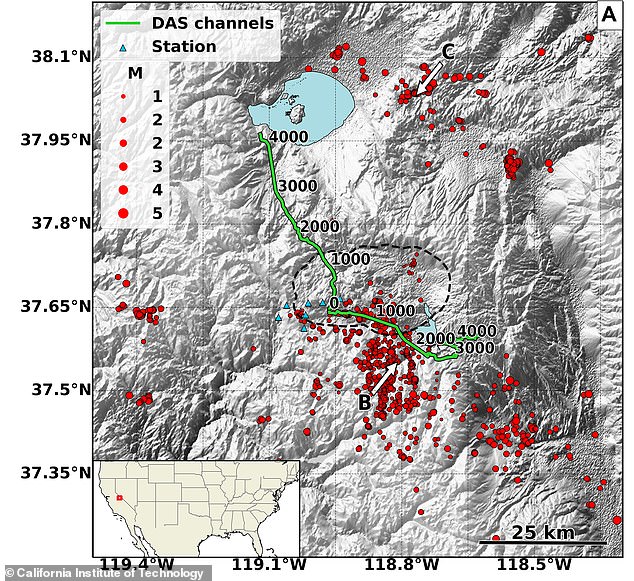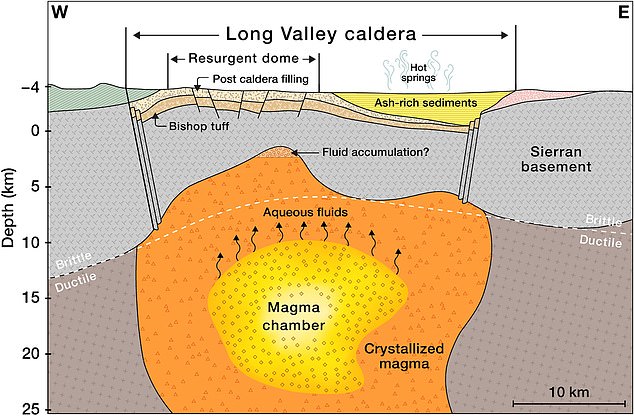Is California’s supervolcano set to blow? Scientists identify more than 2,000 quakes at the Long Valley Caldera that they say ‘are precursors for an eruption’
>
- The giant dormant volcano has increased seismic activity over the years
- Experts have identified more than 2,000 earthquakes throughout the Long Valley Caldera
- Read more: ‘Large’ deadly volcanic eruption in California may be to blame
A California supervolcano, which has the potential to bury Los Angeles in more than 3,000 feet of ash, is showing signs of activity.
Scientists at the California Institute of Technology (Caltech) have identified more than 2,000 earthquakes that have occurred throughout the Long Valley Caldera region in recent years.
The team conducted a new investigation to find out whether the seismic activity is a sign of impending doom or whether the risk of a massive eruption is decreasing.
Caltech researchers created detailed underground images of the caldera and found that recent seismic activity was caused by fluids and gases released when the area cooled and stabilized.

Scientists at the California Institute of Technology (Caltech) have identified more than 2,000 earthquakes that have rocked throughout the Long Valley Caldera in recent years.
“We don’t think the region is preparing for another massive volcanic eruption, but the cooling process may release enough gas and fluid to cause earthquakes and small explosions,” said study author Zhongwen Zhan.
“For example, in May 1980, there were four magnitude 6 earthquakes in the area alone.”
An important result revealed with the images that the volcanic magma chamber is covered by a hardened blanket of crystalline rock, which is formed when liquid magma cools and solidifies.
The long-dormant volcano was the site of a massive eruption 767,000 years ago, which spewed 140 miles of volcanic material into the atmosphere and destroyed Earth.

An important finding with images revealed that the volcanic magma chamber is covered by a hardened mantle of crystallized rock, which was formed when liquid magma cooled and solidified.
Zahn and his team placed dozens of seismometers throughout the Eastern Sierra to capture seismic measurements in a process called distributed acoustic sensing (DAS).
They covered 62 miles of the caldera with cables to capture underground footage.
Over the course of a year and a half, the team used the cable to measure more than 2,000 seismic events, most of which were too small for people to feel.
A machine learning algorithm then processed those measurements and developed the resulting image, which shows the locations of each earthquake.
emily montgomery brown, said an expert at Long Valley Caldera who was not involved in the study Los Angeles Times The earthquake swarms started in 2011.
These earthquakes were then followed by ground deformation in which the ground rose and the tremors dissipated in 2020, leaving the area quiet.
But she warns that a volcanic eruption is still on the table.
A 2018 study found that Long Valley Caldera contains 240 cubic miles of magma below the surface.
“So even if the Long Valley magma reservoir is dying, there are other pockets of magma in the area,” Montgomery-Brown said.
If the caldera erupts, it would surpass the 1980 eruption of Mount St. Helens, which spewed only 0.29 cubic miles of volcanic material into the atmosphere.
In fact, the valley’s 240 cubic miles of magma is enough to fill 400 million Olympic-sized swimming pools.
(Tags for translation)dailymail
